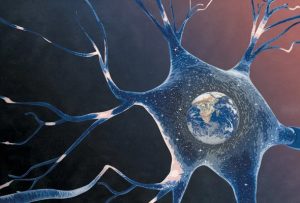
a young course instructor in seminars for medical students, I faithfully taught neurophysiology by the book, enthusiastically explaining how the brain perceives the world and controls the body. Sensory stimuli from the eyes, ears, and such are converted to electrical signals and then transmitted to the relevant parts of the sensory cortex that process these inputs and induce perception. To initiate a movement, impulses from the motor cortex instruct the spinal cord neurons to produce muscular contraction.
Most students were happy with my textbook explanations of the brain’s input-output mechanisms. Yet a minority—the clever ones—always asked a series of awkward questions. “Where in the brain does perception occur?” “What initiates a finger movement before cells in the motor cortex fire?” I would always dispatch their queries with a simple answer: “That all happens in the neocortex.” Then I would skillfully change the subject or use a few obscure Latin terms that my students did not really understand but that seemed scientific enough so that my authoritative-sounding accounts temporarily satisfied them.
Like other young researchers, I began my investigation of the brain without worrying much whether this perception-action theoretical framework was right or wrong. I was happy for many years with my own progress and the spectacular discoveries that gradually evolved into what became known in the 1960s as the field of “neuroscience.” Yet my inability to give satisfactory answers to the legitimate questions of my smartest students has haunted me ever since. I had to wrestle with the difficulty of trying to explain something that I didn’t really understand.
Over the years I realized that this frustration was not uniquely my own. Many of my colleagues, whether they admitted it or not, felt the same way. There was a bright side, though, because these frustrations energized my career. They nudged me over the years to develop a perspective that provides an alternative description of how the brain interacts with the outside world.
The challenge for me and other neuroscientists involves the weighty question of what, exactly, is the mind. Ever since the time of Aristotle, thinkers have assumed that the soul or the mind is initially a blank slate, a tabula rasa on which experiences are painted. This view has influenced thinking in Christian and Persian philosophies, British empiricism and Marxist doctrine. In the past century it has also permeated psychology and cognitive science. This “outside-in” view portrays the mind as a tool for learning about the true nature of the world. The alternative view—one that has defined my research—asserts that the primary preoccupation of brain networks is to maintain their own internal dynamics and perpetually generate myriad nonsensical patterns of neural activity. When a seemingly random action offers a benefit to the organism’s survival, the neuronal pattern leading to that action gains meaning. When an infant utters “te-te,” the parent happily offers the baby “Teddy,” so the sound “te-te” acquires the meaning of the Teddy bear. Recent progress in neuroscience has lent support to this framework.
DOES THE BRAIN “REPRESENT” THE WORLD?
Neuroscience inherited the blank slate framework millennia after early thinkers gave names like tabula rasa to mental operations. Even today we still search for neural mechanisms that might relate to their dreamed-up ideas. The dominance of the outside-in framework is illustrated by the outstanding discoveries of the legendary scientific duo David Hubel and Torsten Wiesel, who introduced single-neuronal recordings to study the visual system and were awarded the Nobel Prize in Physiology or Medicine in 1981. In their signature experiments, they recorded neural activity in animals while showing them images of various shapes. Moving lines, edges, light or dark areas, and other physical qualities elicited firing in different sets of neurons. The assumption was that neuronal computation starts with simple patterns that are synthesized into more complex ones. These features are then bound together somewhere in the brain to represent an object. No active participation is needed. The brain automatically performs this exercise.
The outside-in framework presumes that the brain’s fundamental function is to perceive “signals” from the world and correctly interpret them. But if this assumption is true, an additional operation is needed to respond to these signals. Wedged between perceptual inputs and outputs resides a hypothetical central processor—which takes in sensory representations from the environment and makes decisions about what to do with them to perform the correct action.
So what exactly is the central processor in this outside-in paradigm? This poorly understood and speculative entity goes by various names—free will, homunculus, decision maker, executive function, intervening variables or simply just a “black box.” It all depends on the experimenter’s philosophical inclination and whether the mental operation in question is applied to the human brain, brains of other animals or computer models. Yet all these concepts refer to the same thing.
An implicit practical implication of the outside-in framework is that the next frontier for progress in contemporary neuroscience should be to find where the putative central processor resides in the brain and systematically elaborate the neuronal mechanisms of decision-making. Indeed, the physiology of decision-making has become one of the most popular focuses in contemporary neuroscience. Higher-order brain regions, such as the prefrontal cortex, have been postulated as the place where “all things come together” and “all outputs are initiated.” When we look more closely, however, the outside-in framework does not hold together.
This approach cannot explain how photons falling on the retina are transformed into a recollection of a summer outing. The outside-in framework requires the artificial insertion of a human experimenter who observes this event [see graphic below]. The experimenter-in-the-middle is needed because even if neurons change their firing patterns when receptors on sensory organs are stimulated—by light or sound, for instance—these changes do not intrinsically “represent” anything that can be absorbed and integrated by the brain. The neurons in the visual cortex that respond to the image of, say, a rose have no clue. They do not “see” the appearance of a flower. They simply generate electrical oscillations in response to inputs from other parts of the brain, including those arriving along multiple complex pathways from the retina.
In other words, neurons in sensory cortical areas and even in the hypothetical central processor cannot “see” events that happen in the world. There is no interpreter in the brain to assign meaning to these changes in neuronal firing patterns. Short of a magical homunculus watching the activities of all the neurons in the brain with the omniscience of the experimenter, the neurons that take this all in are unaware of the events that caused these changes in their firing patterns. Fluctuations in neuronal activity are meaningful only for the scientist who is in the privileged position of observing both events in the brain and events in the outside world and then comparing the two perspectives.



